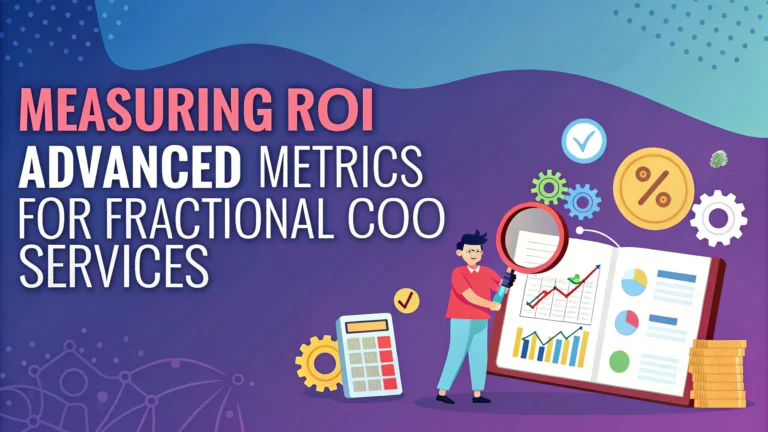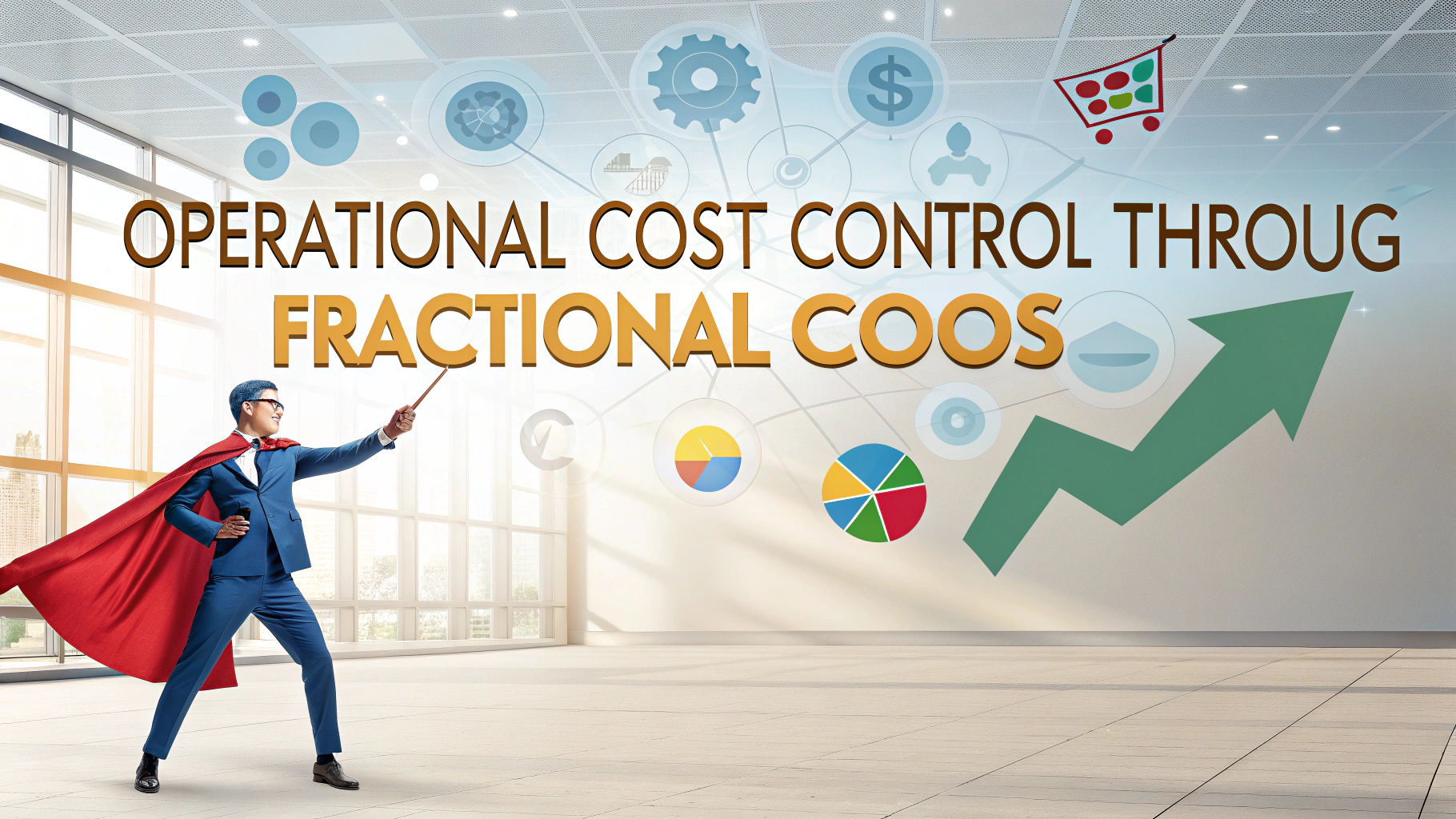Measuring return on investment (ROI) for fractional COO services requires a structured approach that goes beyond traditional financial metrics.
Organizations need clear frameworks to evaluate the impact of their fractional leadership investments across multiple dimensions of business performance.
This guide outlines practical methods to measure and track the effectiveness of your fractional COO engagement using data-driven metrics and performance indicators.
Key Performance Indicators for Fractional COO Success
- Operational Cost Reduction (%)
- Process Efficiency Improvements
- Employee Productivity Metrics
- Project Completion Rates
- Quality Control Measurements
Financial Impact Metrics
Track monthly operational expense reductions against the cost of fractional COO services.
Measure improvements in cash flow management and working capital optimization.
Calculate the cost savings from streamlined vendor relationships and improved contract negotiations.
| Metric | Calculation Method |
|---|---|
| Cost Reduction ROI | (Cost Savings – Fractional COO Fee) / Fractional COO Fee x 100 |
| Revenue Impact | (New Revenue – Previous Revenue) / Previous Revenue x 100 |
Operational Efficiency Measurements
- Average process completion time reduction
- Employee satisfaction scores
- Customer response time improvements
- Inventory turnover rates
- Resource utilization metrics
Project-Based ROI Tracking
Set specific project milestones and track completion rates against predetermined timelines.
Document cost savings and efficiency gains from each implemented initiative.
Measure the long-term sustainability of improvements after project completion.
Team Performance Metrics
- Employee retention rates
- Team productivity scores
- Cross-departmental collaboration metrics
- Training and development effectiveness
Technology Implementation ROI
Calculate time savings from new software and system implementations.
Track error reduction rates in automated processes.
Measure adoption rates of new technology solutions.
Next Steps for Implementation
Begin by establishing baseline measurements before the fractional COO engagement starts.
Create a balanced scorecard that includes both quantitative and qualitative metrics.
Schedule regular review sessions to track progress and adjust metrics as needed.
Document all improvements and maintain detailed records for future reference and reporting.
Taking Action: Your ROI Measurement Plan
Start with the most impactful metrics that align with your business objectives.
Set realistic measurement periods that account for implementation and adjustment times.
Share results with stakeholders regularly to maintain transparency and support for the fractional COO role.
For professional guidance on implementing these metrics, contact the Association of Fractional Executives at www.fractionalexecutives.org.
Systems Integration Assessment
Monitor how effectively new operational systems integrate with existing infrastructure.
Evaluate data flow improvements between departments and systems.
Track reduction in manual processes and duplicate data entry.
Customer Impact Metrics
- Customer satisfaction scores
- Service delivery times
- Order accuracy rates
- Customer retention metrics
- Net Promoter Score changes
Risk Management Evaluation
Measure reduction in operational risks and vulnerabilities.
Track compliance improvement rates.
Document incident response time improvements.
Risk Reduction Metrics
- Compliance violation reduction
- Insurance premium savings
- Safety incident frequency
Long-Term Value Creation
Assess sustainable process improvements that continue after the engagement.
Measure knowledge transfer effectiveness to internal teams.
Track the development of internal leadership capabilities.
| Value Metric | Measurement Frequency |
|---|---|
| Process Documentation Quality | Quarterly |
| Team Leadership Development | Semi-annually |
Maximizing Your Fractional Leadership Investment
Regular assessment of these metrics ensures optimal value from your fractional COO engagement.
Focus on both immediate improvements and long-term organizational capability building.
Maintain detailed documentation to demonstrate ROI and guide future strategic decisions.
Consider implementing a formal review process to continuously refine and optimize the fractional leadership model for your organization.
FAQs
- What are the key metrics used to measure ROI for fractional COO services?
The primary metrics include cost savings, operational efficiency improvements, revenue growth, process optimization metrics, employee productivity gains, reduction in operational expenses, time-to-market improvements, and quality control metrics. - How do you calculate the financial impact of a fractional COO?
Calculate by measuring [(Cost savings + Revenue increase + Efficiency gains) – Cost of fractional COO services] / Cost of fractional COO services x 100. Include both direct financial impacts and indirect benefits like improved team productivity. - What is the typical timeframe for seeing measurable results from a fractional COO?
Most organizations begin seeing measurable results within 3-6 months, with significant ROI typically visible within 6-12 months, depending on the scope of improvements and organizational complexity. - How do you measure operational efficiency improvements from fractional COO services?
Track key performance indicators (KPIs) such as process cycle times, resource utilization rates, error rates, throughput metrics, and operational costs per unit before and after implementing changes. - What benchmarking methods are used to evaluate fractional COO performance?
Industry standard benchmarks, historical company performance data, competitor analysis, and standardized operational metrics are used to create baseline measurements and track improvements. - How do you assess the qualitative benefits of a fractional COO?
Evaluate through employee satisfaction surveys, customer feedback, organizational culture improvements, team alignment metrics, and stakeholder interviews to measure non-financial impacts. - What technology tools are recommended for tracking fractional COO ROI?
Enterprise resource planning (ERP) systems, business intelligence dashboards, project management software, performance tracking tools, and analytics platforms are commonly used to monitor and measure ROI. - How do you measure the impact on team performance and development?
Track employee turnover rates, productivity metrics, skill development progress, internal promotion rates, and team capability assessments before and after fractional COO engagement. - What risk reduction metrics should be considered when measuring fractional COO ROI?
Measure decreased incident rates, improved compliance scores, reduced liability exposure, enhanced risk management processes, and lower insurance premiums resulting from improved operations. - How frequently should ROI metrics be reviewed for fractional COO services?
Monthly tracking of operational metrics with quarterly comprehensive ROI reviews is recommended, along with annual strategic impact assessments.







